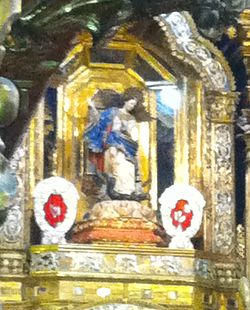Virgin of Quito
 |
|
| Artist | Bernardo de Legarda |
|---|---|
| Year | 1734 |
| Type | Wood, polychrome, silver (diadem), gold leaf |
| Dimensions | 30 cm (12 in) |
| Location | Church and Convent of St. Francis, Quito, Ecuador |
The Virgin of Quito (Spanish, La Virgen de Quito) — also known as the Virgin of the Apocalypse, Winged Virgin of Quito, Dancing Madonna, and Legarda's Virgin — is a wooden sculpture by the Quiteño artist Bernardo de Legarda (ca. 1700-1773) which has become the most representative example of the Quito School of art, developed in the Ecuadorian capital during the Spanish colonial era. This particular Virgin became a popular cult image which is still venerated — via innumerable replicas — throughout the northern Andes.
The original 1734 work was conceived and commissioned as a Lady of the Immaculate Conception and is venerated at the altar of the Church and Convent of San Francisco in Quito, Ecuador.
The composition of the 30-centimeter-high sculpture is derived from the biblical description of the Woman of the Apocalypse. As described in the Revelation of Saint John (12:1-2), the woman was “clothed in the sun”. Also in accordance with the text, she has a crescent moon under her feet and a silver diadem bearing 12 stars is on her head. After battling a dragon — i.e., Satan, with the apple of original sin in his mouth — she has trampled and subdued the beast with a heavy silver chain which she holds loosely in her open hands. She has been given silver wings for escape. Probably influenced by 16th century European prints, such as that of Albrecht Dürer’s Revelation series, the “dancing” Virgin seems to float and gestures with open hands to her right amid an abundance of flouncing folds conveying both flight and ecstasy. Her mantle is of deep blue and bears silver stripes at the bottom. According to Michael Handelsman, "unlike the fair-skinned European Virgins, she clearly has the facial features and coloring of a mestiza". The work was signed and dated by its creator.
...
Wikipedia
